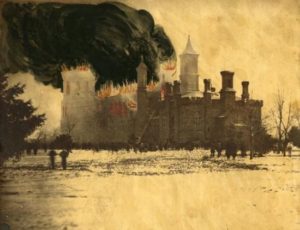 One scientific institution that Lincoln had protected and advanced during the war took a major hit on the frigid winter’s afternoon of January 24, 1865. Joseph Henry sat in his third-floor office in the Smithsonian Castle, alternatively updating his notebook and staring out the great rose window squeezed between the two front towers. Stirring, he noticed a sooty burning odor. Likewise, his daughter Mary was reading in the library until she noticed the room darkening, a thick cloud of smoke obscuring the view. The Castle was on fire!
One scientific institution that Lincoln had protected and advanced during the war took a major hit on the frigid winter’s afternoon of January 24, 1865. Joseph Henry sat in his third-floor office in the Smithsonian Castle, alternatively updating his notebook and staring out the great rose window squeezed between the two front towers. Stirring, he noticed a sooty burning odor. Likewise, his daughter Mary was reading in the library until she noticed the room darkening, a thick cloud of smoke obscuring the view. The Castle was on fire!
Rushing to save whatever they could, father and daughter managed to grab a few books, some papers, and a bit of clothing. Others arrived to help pull out furniture items. Flames poured out the tower windows and scorched the ornamental stonework. Mary described it as “a beautiful friend tasting to the utmost the pleasure of destruction.” Her poetical observation was interrupted as the flames reached the top of the tower, where Henry’s papers were kept, destroying a historical and scientific record that had taken a lifetime to build.
Investigations showed that the fire was accidental, a result of negligence. Men renovating the building had vented a stove exhaust pipe into an air chamber inside the wall rather than to an external vent. After smoldering for days, the heated wood had finally erupted into flames. Destroyed was the apparatus room, the picture gallery, the regents’ room, and the lecture hall. Among the treasures lost were all James Smithson’s personal effects, including the manuscripts, meteorites, and minerals that had seeded the new institution. Also lost were an extensive collection of scientific instruments and nearly a hundred thousand letters and reports documenting the founding of the institution and a decade of scientific research from all over the world. All of James Smithson’s unpublished scientific research was lost forever. It would take twelve years and $125,000 to repair the building and correct faulty construction. Indirectly lost was James Melville Gillis, chief astronomer and director of the Naval Observatory, who succumbed to exhaustion during the building evacuation and suffered a fatal stroke two weeks later. Saved was Smithson’s small personal collection of books. Only 115 volumes and never bound in leather covers, they at least provide some surviving connection to the man who made the Smithsonian possible.
Two days after the fire, Henry shambled to the White House. Lincoln “expressed much sympathy” and ordered the War Department to raise a temporary roof over the scorched portions of the Castle. Montgomery Meigs, a longtime friend of Henry and one of Lincoln’s favorite engineers, pulled together the needed materials and carpenters to build a roof designed by architect Edward Clark. Henry would spend the next several months organizing renovations, taking time out to attend Lincoln’s second inaugural on March 4. At his side was Mary Henry, who made a passing reference to seeing the famous actor John Wilkes Booth in the balcony above them.
Lincoln’s lifelong enthusiasm for science and technology, combined with his belief that the federal government should help the populace better their condition, made him an amenable partner of congressional efforts to institutionalize science. Once suspicious of scientists because of their overall elitism and the preponderance of con men, the national attitude toward science had begun to change. No longer the sole realm of a wealthy elite, technological advances were more and more affecting the masses, in part due to a refocusing on practical science rather than less publicly relatable theoretical research.
[Excerpted from Lincoln: The Fire of Genius: How Abraham Lincoln’s Commitment to Science and Technology Helped Modernize America, available at all bookseller outlets]
NOTE: Not only is January 24th the anniversary of the fire, but there is significant current news regarding the Smithsonian Castle. The Castle will close on February 1, 2023, for renovations that are expected to take five years to complete.
[Check out my Media page for upcoming events and videos/audio of previous presentations and podcasts]
[Colorized photo of Smithsonian fire from Smithsonian Institution Archives. Full info here]

Lincoln: The Fire of Genius: How Abraham Lincoln’s Commitment to Science and Technology Helped Modernize America is available at booksellers nationwide.
Limited signed copies are available via this website. The book also listed on Goodreads, the database where I keep track of my reading. Click on the “Want to Read” button to put it on your reading list. Please leave a review on Goodreads and Amazon if you like the book.
You also follow my author page on Facebook.
David J. Kent is President of the Lincoln Group of DC and the author of Lincoln: The Fire of Genius: How Abraham Lincoln’s Commitment to Science and Technology Helped Modernize America and Lincoln: The Man Who Saved America.
His previous books include Tesla: The Wizard of Electricity and Edison: The Inventor of the Modern World and two specialty e-books: Nikola Tesla: Renewable Energy Ahead of Its Time and Abraham Lincoln and Nikola Tesla: Connected by Fate.










